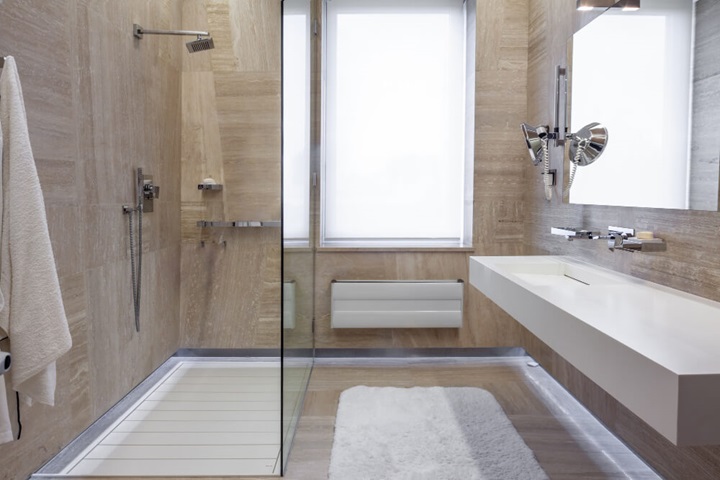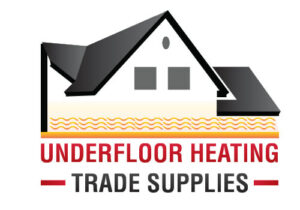No one likes a cold wet room floor. Want a heating solution that doesn’t clutter the space? Underfloor heating is the solution you need.
Underfloor heating in wet rooms is becoming a go-to choice for contemporary homeowners looking for both comfort and practicality. In this article, we’ll walk you through everything you need to know about wet room underfloor heating—from system types and installation tips to heating shower trays and walls. Whether you’re designing a new wetroom for new builds or upgrading an old property, we have the advice you need to create a warmer, safer space that works all year round.
Key Points:
- Wetroom underfloor heating is ideal for open-plan, tiled space.
- Both electric and water underfloor heating systems can be used, depending on the setup.
- Shower trays and even wet room walls can be safely heated.
- Underfloor heating helps reduce mould and keeps floors dry.
- It’s possible to retrofit underfloor heating into existing wet rooms.
- Is Underfloor Heating Suitable for Wet Rooms?
- Best Electric Heaters for Wet Rooms
- Can Water Underfloor Heating Be Used in Wet Rooms?
- Can I Install Underfloor Heating Under a Shower Tray?
- Can You Heat the Walls in a Wet Room?
- The Benefits of Wet Room Underfloor Heating
- Other Ways to Improve Comfort in a Wetroom
- Combining Wetrooms with Underfloor Heating
- Let Us Help With Your Wet Room Underfloor Heating
- FAQs
- Sources
Is Underfloor Heating Suitable for Wet Rooms?
Wet rooms are made for underfloor heating. Their open layout, tiled surfaces, and waterproof construction create the perfect environment for floor heating to work at its best. With no need for radiators hogging up wall space, you can enjoy a cleaner, more flexible space that’s warm underfoot every time you step in.
Many homeowners now see underfloor heating as a smart long-term investment, not just a luxury. Just by spending a portion of your bathroom budget on underfloor heating can make practical and financial sense in the right setup.
The materials commonly used in wet rooms—such as porcelain, ceramic, and natural stone—are ideal for heat distribution. These tiles warm up fast and hold onto the heat, making the entire floor a gentle heat source that dries quickly and stays comfortable. This is one of the key reasons underfloor heating in wet rooms has become a popular choice for both new builds and renovations.
A properly sealed wetroom floor also protects the system below, keeping moisture away from the heating components. With the right design and layout, wet room underfloor heating can help reduce damp spots and mould buildup, especially in colder months.
Tiled wetroom floors are excellent heat conductors. Once warm, they retain heat efficiently—helping lower running costs and keeping the space consistently comfortable.
Of course, no wetroom is without its problems, but underfloor heating installations can greatly decrease these from occurring.
Best Electric Heaters for Wet Rooms
If you’re planning a bathroom upgrade or a full wet room build, electric underfloor heating is a great option. It’s quick to install, works well in smaller spaces, and delivers heat fast—ideal for morning routines or chilly evenings.
One of the top systems for wetroom underfloor heating is a decoupling mat with built-in heating cables. These mats are designed specifically for use under tiles and offer extra protection against tile movement or cracking. Some systems also include waterproof tape, helping to reinforce the sealed barrier beneath your flooring.
Electric underfloor heating kits are especially useful for one-room projects or when you want to avoid the extra floor build-up of a water system. They’re thin, reliable, and easy for a professional to fit. Learn about underfloor heating tile problems if you have encountered issues with your tiles.
Can Water Underfloor Heating Be Used in Wet Rooms?
Yes, water underfloor heating is a solid option—particularly for new builds. These systems are usually integrated into the subfloor during construction and work by circulating warm water through pipes embedded in the screed.
If your wet room is part of a renovation, low-profile systems (like those using diffusion plates and insulation boards) can work just as well, keeping heat consistent while preserving floor height.
Can I Install Underfloor Heating Under a Shower Tray?
Heating the area beneath a shower tray is possible, but it must be done correctly. While the idea of stepping onto a warm shower base sounds appealing, there are safety and efficiency factors to keep in mind.
Underfloor heating in a wet room can be installed beneath a shower tray, but only if the correct build-up is in place. The heating system—whether electric underfloor heating or water-based—should not sit directly underneath the tray. Instead, there needs to be enough screed or other heat-conductive material (at least 12mm) between the system and the tray. Without this buffer, the heat can’t escape properly, increasing the risk of system failure or damage to the tray.
If your wetroom design includes a low-profile or flush shower tray, it’s often better to run the heating system right up to the tray’s edge rather than directly beneath it. This still keeps the surrounding floor warm and helps with water drying and comfort.
Installation is usually straightforward for a qualified installer and can often be completed in just a day. Always consult with a heating specialist to make sure your layout, waterproofing, and chosen system are all compatible.
Can You Heat the Walls in a Wet Room?
Yes, wall heating can be used in a wetroom to support or complement floor systems—especially in colder rooms or poorly insulated spaces. These systems are typically installed behind tiles or panels and work well when linked with underfloor heating to keep the whole space warm.
Wall heating provides direct heat to the areas you lean on or stand next to in the shower, adding comfort while reducing surface moisture and condensation. It’s often used in tiled areas near walk-in showers or baths where traditional heating won’t reach.
If you’re using a water-based system, wet underfloor heating kits can often be extended to include wall loops. This lets you control both floor and wall temperatures from the same thermostat—ideal for multi-zone heating setups.
The Benefits of Wet Room Underfloor Heating

There’s more to wetroom underfloor heating than just keeping your feet warm. A well-designed system brings a number of practical benefits to your space—many of which go unnoticed until you’ve lived with them.
Here are some of the key reasons homeowners choose underfloor heating in wet rooms:
- Comfortable surface temperature: Always warm underfoot, especially during colder months.
- Even heat distribution: No cold corners or uneven patches—just consistent warmth.
- Space-saving: Removes the need for wall-mounted radiators, freeing up the layout.
- Low maintenance: Once installed, there’s little to no upkeep required.
- Energy efficiency: Electric UFH is 100% efficient at point of use.
- Faster drying: Helps to dry floors quickly, reducing damp and mould risk.
- Added property value: Wet rooms with UFH are often seen as modern, high-spec features.
Whether you’re upgrading a small ensuite or building a large walk-in shower, wet room underfloor heating can make the space more usable, comfortable, and easier to maintain.
Other Ways to Improve Comfort in a Wetroom
Dry floors in wetrooms aren’t just about comfort—they’re also about safety. There are several tips for keeping a wet room dry, safe and slip-free, including how heating systems can help speed up drying and reduce standing water.
Aside from wet room underfloor heating, there are other small design touches that can help improve daily comfort and prevent damp issues.
Here are some ideas:
- Add a heated towel rail: These don’t take up much space and provide a separate source of warmth for towels.
- Install a thermostatic control system: For better accuracy, especially in multi-zone heating setups.
- Use non-slip tiles: Comfort isn’t just about temperature—safety plays a big part too.
- Consider a floating vanity unit: Keeps floor space clear, allowing better heat flow from the underfloor system.
- Plan your lighting: Good lighting can make a small wetroom feel bigger, warmer, and more inviting.
If you’re upgrading an existing bathroom, retrofitting underfloor heating is now much easier than many think. Low profile underfloor heating means you can add heat without raising floor levels too much or needing major work.
For a wide range of bathroom underfloor heating solutions, from small en-suites to larger walk-in wetrooms, there’s a system to suit every project.
Combining Wetrooms with Underfloor Heating
The demand for wetroom underfloor heating is growing fast—and not just in homes. While most installations still take place in new builds and domestic renovations, more commercial and care environments are now seeing the benefit of this combination too.
Open-plan living trends and cleaner design layouts have made wetrooms popular among homeowners, designers, and developers. Combined with the clean, hidden comfort of underfloor heating, they offer an uncluttered finish that still feels warm and practical.
This makes them a smart choice not only for families but also for hotels, gyms, student flats, and assisted living spaces.
With the right system in place, underfloor heating in wet rooms can deliver long-term comfort, better energy use, and easier cleaning—all without getting in the way of the design.
Let Us Help With Your Wet Room Underfloor Heating
With Underfloor Heating Trade Supplies, you’ll find everything you need to heat your wetroom effectively. From wet underfloor heating kits to slimline solutions perfect for retrofits, our systems are made to work with modern bathroom layouts.
Whether you’re heating a tiled walk-in shower or managing multi-zone heating across several rooms, our expert team can help you choose the right products for your space.
FAQs
Can underfloor heating help prevent mould or damp in wet rooms?
Yes. The consistent and gentle heat distribution from underfloor heating helps dry out moisture on the floor quickly, reducing the risk of damp spots, mould growth, and bacteria buildup—particularly important in humid, tiled environments.
Is it possible to retrofit underfloor heating into an existing wet room?
Yes, retrofitting is possible. Low-profile electric or water UFH systems are ideal for renovations as they require minimal floor build-up. A qualified installer can assess whether the existing layout and waterproofing need adjustments.
Can I use a towel rail or radiator alongside underfloor heating in a wet room?
Absolutely. While underfloor heating can serve as the primary heat source, many homeowners choose to install a heated towel rail for added comfort and to keep towels warm and dry. It’s a practical and aesthetic addition to the space.
Sources
Brinsmead, N., (2025) How do you keep a wet room dry? 7 tips for a slip-proof shower room. Ideal Home. [online] Available at: https://www.idealhome.co.uk/all-rooms/bathroom/how-to-keep-a-wet-room-dry [accessed 07/08/2025]
Glantz, M., (2025) Is It Really Worth Spending Your Bathroom Budget on Underfloor Heating? Here’s Our Verdict. Living Etc. [online] Available at: https://www.livingetc.com/advice/underfloor-heating-in-a-bathroom [accessed 07/08/2025]
CCL Wetrooms. (2021) The Horror! Preventing Wet Room Nightmares.. [online] Available at: https://www.ccl-wetrooms.co.uk/blog/horror-preventing-wet-room-nightmares/ [accessed 07/08/2025]
